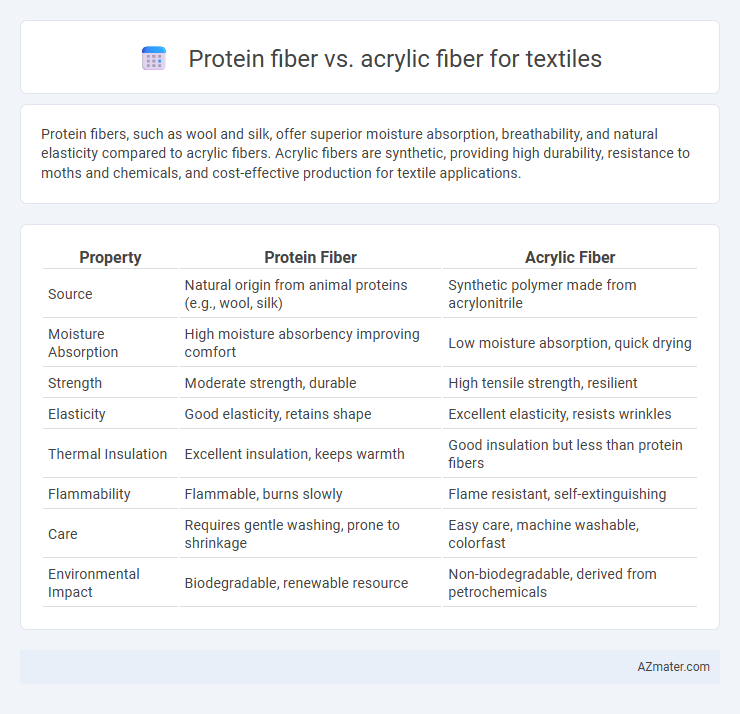Protein fibers, such as wool and silk, offer superior moisture absorption, breathability, and natural elasticity compared to acrylic fibers. Acrylic fibers are synthetic, providing high durability, resistance to moths and chemicals, and cost-effective production for textile applications.
Table of Comparison
| Property | Protein Fiber | Acrylic Fiber |
|---|---|---|
| Source | Natural origin from animal proteins (e.g., wool, silk) | Synthetic polymer made from acrylonitrile |
| Moisture Absorption | High moisture absorbency improving comfort | Low moisture absorption, quick drying |
| Strength | Moderate strength, durable | High tensile strength, resilient |
| Elasticity | Good elasticity, retains shape | Excellent elasticity, resists wrinkles |
| Thermal Insulation | Excellent insulation, keeps warmth | Good insulation but less than protein fibers |
| Flammability | Flammable, burns slowly | Flame resistant, self-extinguishing |
| Care | Requires gentle washing, prone to shrinkage | Easy care, machine washable, colorfast |
| Environmental Impact | Biodegradable, renewable resource | Non-biodegradable, derived from petrochemicals |
Introduction to Protein Fibers and Acrylic Fibers
Protein fibers, derived from natural sources such as wool, silk, and alpaca, possess excellent moisture absorption, warmth retention, and biodegradability, making them highly valued in textile applications. Acrylic fibers, synthetic polymers primarily made from acrylonitrile, offer superior resistance to sunlight, chemicals, and mildew while providing lightweight and soft fabric alternatives that mimic wool. Understanding the fundamental differences in composition and performance between protein and acrylic fibers is essential for selecting the appropriate material for specific textile needs.
Origin and Production Processes
Protein fibers, derived primarily from animal sources such as wool, silk, and alpaca, originate from natural protein structures like keratin and fibroin and undergo processes like shearing, cleaning, and spinning for textile production. Acrylic fibers, synthesized from polyacrylonitrile through polymerization and dry or wet spinning methods, mimic natural wool in texture but are entirely petroleum-based and chemically produced. The fundamental difference lies in protein fibers being biogenic and renewable, while acrylic fibers depend on petrochemical raw materials and industrial polymer processing.
Molecular Structure and Composition
Protein fibers, such as wool and silk, consist mainly of keratin and fibroin proteins with complex, naturally occurring polypeptide chains that provide inherent elasticity and moisture absorption. Acrylic fibers are synthetic polymers primarily composed of polyacrylonitrile, featuring long carbon-based chains with nitrile groups that offer high strength, durability, and resistance to UV and chemicals. The molecular structure of protein fibers enables superior breathability and dye affinity, while acrylic fibers deliver consistent shape retention and hydrophobic properties essential for textile performance.
Key Physical Properties Comparison
Protein fibers like wool and silk exhibit excellent moisture absorption, high elasticity, and natural thermal insulation, making them ideal for comfort-oriented textiles. Acrylic fibers offer superior resistance to sunlight and chemicals, along with higher tensile strength and quick-drying properties compared to protein fibers. Both fiber types differ significantly in abrasion resistance, with acrylic providing enhanced durability, while protein fibers typically deliver better resilience and softness.
Comfort and Aesthetic Qualities
Protein fibers such as wool and silk offer superior comfort due to their natural breathability, moisture-wicking properties, and softness against the skin compared to acrylic fibers, which can trap heat and cause irritation. In terms of aesthetic qualities, protein fibers provide a rich, lustrous appearance with excellent drape and a natural sheen, while acrylic fibers mimic wool's texture but often lack the depth and elegance found in natural protein fibers. The durability and color retention of acrylic fibers can complement their lower cost, but protein fibers remain preferred for high-end textiles prioritizing comfort and refined aesthetics.
Durability and Care Requirements
Protein fibers like wool and silk offer natural resilience and breathability but require gentle care to prevent shrinking and damage from moisture. Acrylic fibers provide high durability, excellent resistance to wear, and easier maintenance due to their synthetic nature, including machine washability and quick drying. Choosing between the two depends on balancing the natural comfort of protein fibers against the superior durability and low maintenance of acrylic fibers for textile applications.
Environmental Impact and Sustainability
Protein fibers like wool and silk are biodegradable and renewable, offering a lower environmental footprint compared to synthetic acrylic fibers derived from fossil fuels. Acrylic fiber production involves significant greenhouse gas emissions and non-biodegradable waste, contributing to long-term environmental pollution. Choosing protein fibers supports sustainable textile practices through reduced carbon emissions and enhanced biodegradability, aligning with eco-friendly goals.
Cost Efficiency and Market Availability
Protein fibers such as wool and silk offer superior moisture absorption and thermal regulation compared to acrylic fibers, which are synthetic and generally cheaper to produce. Acrylic fibers dominate the market due to their low cost, ease of production, and wide availability, making them a preferred choice for budget-conscious manufacturers. While protein fibers incur higher costs from animal-derived sourcing, their niche market emphasizes quality and durability, contrasting with acrylic's cost efficiency and mass-market accessibility.
Common Applications in Textiles
Protein fibers like wool and silk are widely used in textiles for clothing, upholstery, and luxury items due to their natural elasticity, moisture-wicking properties, and softness. Acrylic fibers serve as synthetic alternatives in sweaters, blankets, and outdoor fabrics, prized for their lightweight durability, colorfastness, and resistance to moths. Both fiber types find roles in textiles where specific performance, texture, and care requirements dictate their suitability for garments, home furnishings, and industrial uses.
Choosing Between Protein and Acrylic Fibers
Protein fibers like wool and silk offer excellent moisture absorption, breathability, and natural elasticity, making them ideal for comfortable, high-end textiles. Acrylic fibers provide durability, resistance to mildew and UV damage, and affordability, often used in budget-friendly and easy-care fabric applications. Choosing between protein and acrylic fibers depends on the desired balance of natural feel, thermal regulation, maintenance ease, and cost efficiency for the intended textile use.

Infographic: Protein fiber vs Acrylic fiber for Textile
 azmater.com
azmater.com